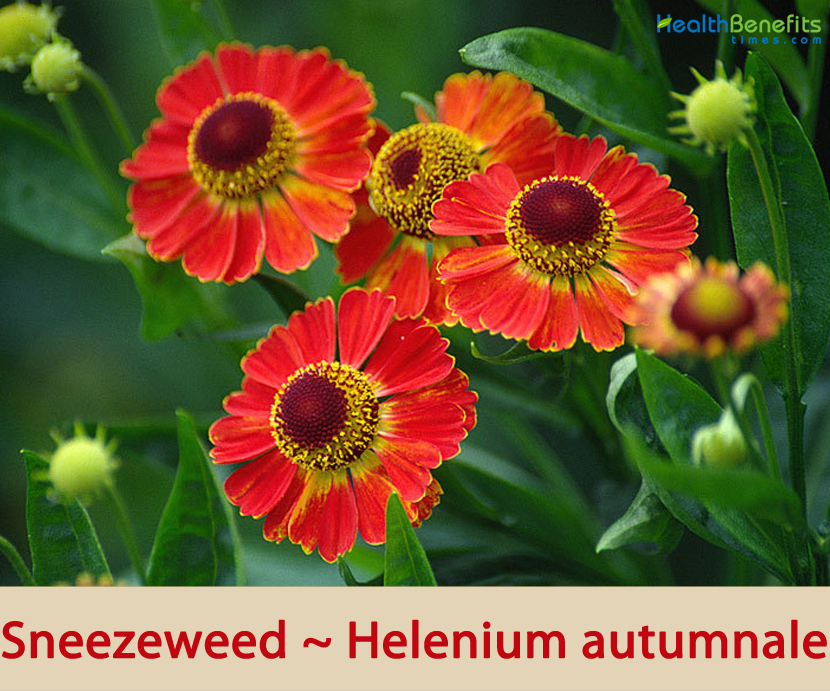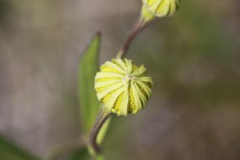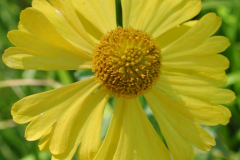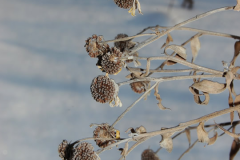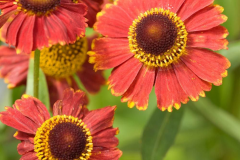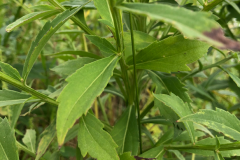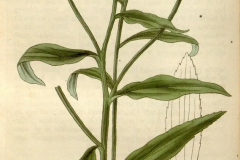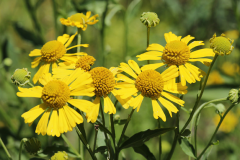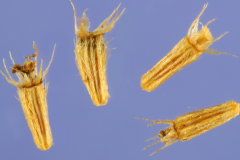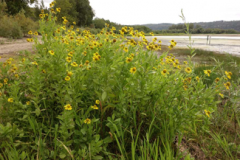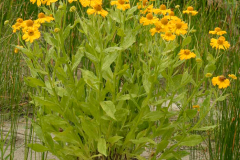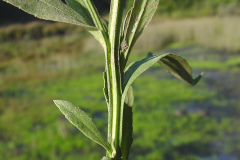| Sneeze Weed Quick Facts | |
|---|---|
| Name: | Sneeze Weed |
| Scientific Name: | Helenium autumnale |
| Origin | United States and Canada, from Northwest Territories as far south as far northern California, Arizona, Louisiana, and Florida |
| Colors | Brown or rust-colored |
| Shapes | Dry, one-seeded, 1 ⁄16 inches long seed capsule |
| Taste | Pungent, bitter, Acrid |
| Health benefits | Support for head colds, respiratory infections, intestinal worms, fevers, sprains, sore joints, torn ligaments and bruising |
| Name | Sneeze Weed |
|---|---|
| Scientific Name | Helenium autumnale |
| Native | United States and Canada, from Northwest Territories as far south as far northern California, Arizona, Louisiana, and Florida |
| Common Names | Sneezeweed, Common sneezeweed, Fall sneezeweed, Mountain sneezeweed, False Sunflower, autumn sneezeweed, bitterweed smooth oxeye, mountain sneezeweed, Helen’s flower, Large-flowered Sneezeweed, Dogtooth-daisy |
| Name in Other Languages | Afrikaans: Sneezeweed Albanian: Sneezeweed Amharic: Ashikerekerewi (አሽከረከረው) Arabic: Aeshab (اعشاب) Armenian: P’rrshtal (փռշտալ) Azerbaijani: Asqırmaq Bengali: Sneezeweed Bulgarian: Sneezeweed Burmese: Naypyitaw (နေပြည်တော်) Chinese: Pēntì (喷嚏) Croatian: Sneezeweed Czech: Kýchnutí, záplevák podzimní Danish: Sneezeweed, Høst-solbrud Dutch: Nieskruid English: Sneezeweed, Common sneezeweed, Fall sneezeweed, Mountain sneezeweed, Swamp sunflower, tall sneezeweed Esperanto: Kaŝvestita Estonian: Aevastatud, sügisheleenium Filipino: Sneezeweed Finnish: Sneezeweed French: Eternuements, Hélénium, Hélénie automnale, Hélénie d’automne Georgian: Shemogep’arot (შემოგეპაროთ) German: Niesen, Gewöhnliche Sonnenbraut, Herbst-Sonnenbraut, Gewöhnlicher Sonnenbraut Greek: Ftérnisma (φτέρνισμα) Gujarati: Chīṅka āvē chē (છીંક આવે છે) Hausa: Sneezeweed Hebrew: עייף Hindi: Sneezeweed Hungarian: Sneezeweed, őszi napfényvirág Icelandic: Sneezeweed Indonesian: Bersin Irish: Sneezeweed Italian: Helenium autumnale Japanese: Kushami (くしゃみ), dangogiku (ダンゴギク) Javanese: Rasane Kannada: Sīnuvike (ಸೀನುವಿಕೆ) Kazakh: Tüşkirw (түшкіру) Korean: Jaechaegi (재채기) Kurdish: Sneezeweed Lao: Sneezeweed Latin: Sneezeweed Latvian: Sķavas Lithuanian: Ciaudulys Macedonian: Kivavica (кивавица) Malagasy: Sneezeweed Malay: Sneezeweed Malayalam: Tum mal (തുമ്മൽ) Maltese: Sneezeweed Marathi: Śiṅkā yēṇē (शिंका येणे) Mongolian: Naitaakh (найтаах) Nepali: Chheenkiekee (छींकिएकी) Norwegian: Sneezeweed Oriya: ଛିଙ୍କିବା Pashto: چینایی Persian: عطسه Polish: Kichanie, dzielżan jesienny, helenka jesienna Portuguese: Sneezeweed Punjabi: Chika (ਛਿੱਕ) Romanian: Sneezeweed Russian: Sneezeweed, gelenium osenniy (гелениум осенний) Serbian: Sneezeveed (снеезевеед) Sindhi: نِڪ Sinhala: Kivisum (කිවිසුම්) Slovak: Helénium jesenné Slovenian: Kihne Spanish: Estornudo Sundanese: Bersin Swedish: Sneezeweed, Solbrud Tajik: Sneezeweed Tamil: Tum mal (தும்மல்) Telugu: Sneezeweed Thai: Sneezeweed Turkish: Sneezeweed Ukrainian: Chav (чхав) Urdu: چھینک Uzbek: Hapşırma Vietnamese: Hít vào Welsh: Tisian, Blodau Tisian, Blodyn Tisian Zulu: Athuke |
| Plant Growth Habit | Upright, clumping, fibrous-rooted, perennial wildflower |
| Growing Climates | Wet meadows, marshes, rich thickets, meadows, shores, moist calcareous soils, wet openings, edges, along rivers, streams and ponds, mesic hardwoods floodplains, sandy alluvial dikes, drainage ditches, pine flat wood depressions, wet woodlands, wet roadsides, moist soil of limestone bluffs, moist Blackland prairies, fens, forests, seepage areas, soil prairies, railroads, poorly drained pastures and abandoned fields |
| Soil | Prefers loamy or silty soils that are high in organic matter. Plants thrive in wet or evenly moist soil but will tolerate a bit of drought after establishment |
| Plant Size | Can reach 2 to 5 feet in height and 2 to 3 feet in width |
| Stem | Stems are erect or ascending, winged, and branched above the middle. Above the middle the stems are moderately to densely covered with short, spreading to ascending, somewhat curled hairs |
| Leaf | Sneezeweed leaves are lance-shaped to narrowly oval, with a few teeth. These leaves occur alternately on the stem. They are directly attached, with the leaf base continuing down the stem as a wing |
| Flowering season | August to October |
| Flower | The heads are several to numerous at the tips of the branches. Both the disk and ray flowers are yellow. The disk measures 1-2 cm wide, and the 10-20 rays are 1.5-2.5 cm long. |
| Fruit Shape & Size | Dry, one-seeded, 1 ⁄16 inches long seed capsule (cypsela) |
| Fruit Color | Brown or rust-colored |
| Taste | Pungent, bitter, Acrid |
| Plant Parts Used | Leaves, stem |
| Propagation | By seed in spring, by division in autumn or spring, or by basal softwood cuttings in containers in a cold frame in spring |
| Lifespan | Survive from 4 to 5 years in the wild |
| Season | June through November |
| Available Forms | Infused oil, salve, liniment, or poultice |
Plant Description
Sneezeweed is an erect, upright, clump-forming, fibrous-rooted, perennial wildflower with stout green winged stems and shallow fibrous roots. The plant normally grows about 2 to 5 feet in height and 2 to 3 feet in width. The plant is found growing in wet meadows, marshes, rich thickets, meadows, shores, moist calcareous soils, wet openings, edges, along rivers, streams and ponds, mesic hardwoods floodplains, sandy alluvial dikes, drainage ditches, pine flat wood depressions, wet woodlands, wet roadsides, moist soil of limestone bluffs, moist black land prairies, fens, forests, seepage areas, soil prairies, railroads, poorly drained pastures and abandoned fields. The plant prefers loamy or silty soils that are high in organic matter. Plants can thrive in wet or evenly moist soil but will tolerate a bit of drought after establishment.
Stem
Stems are erect or ascending, winged, and branched above the middle. Above the middle the stems are moderately to densely covered with short, spreading to ascending, somewhat curled hairs. They are also moderately covered with yellow, stalk less or impressed glands. Below the middle the stem is sparsely to moderately hairy.
Leaves
Stem leaves are alternate, stalk less, numerous, and spread outward. The leaves are longest at the middle of the stem, becoming slightly smaller as they ascend the stem. The upper and lower surfaces are sometimes hairless but are usually moderately to densely covered with short, mostly spreading, sometimes curved hairs. They are also densely dotted with yellow, stalk less or impressed glands. Middle and upper stem leaves are 1½ inches to 6 inches long and 3 ⁄16 inches to 2 inches wide. Basal and lower leaves are somewhat smaller than middle stem leaves. Basal leaves are lance-shaped, inversely lance-shaped, or inversely egg-shaped, and are sometimes cut with shallow, rounded lobes (pinnatifid). Lower and middle stem leaves are inversely egg-shaped to inversely lance-shaped. They are tapered at the base and angled or taper to a sharp point at the tip. The base of the leaf blade continues down the stem as a narrow, green wing. The margins are either untoothed or are toothed often only above the middle of the blade. Upper stem leaves are inversely lance-shaped to lance-shaped but otherwise similar to middle stem leaves. Basal and lower stem leaves are absent or withered by flowering time.
Flower
The inflorescence is 2 to 25 flower heads in open, leafy, branched, panicle-like clusters at the end of the stems and branches. Each cluster is on a ¾ inches to 3 inches long, sparsely to moderately hairy stalk. The whorl of 15 to 21 green bracts at the base of the flower head (involucre) is globe-shaped, 5 ⁄16 inches to ⅝ inches long, and ⅜ inches to ⅝ inches in diameter. The bracts of the involucre (phyllaries) are in 2 series. The outer phyllaries are fused at the base.
Each flower head is 1 inch to 2½ inches in diameter. There are 8 to 21 ray florets and 200 to 400 or more disk florets. The ray florets are yellow, ⅜ inches to 1 inch long and ⅛ inches to ⅜ inches wide and double notched at the tip. They are narrow at the base and taper evenly to a broad tip. The disk florets are yellow to brownish and form a large, globe-shaped, sometimes somewhat flattened disk. Flower stalks are finely hairy and slightly swollen at the base of the flower. Flowers appear over a lengthy late summer to autumn (sometimes to first frost) bloom as indicated by species name. Flowering normally takes place in between August to October.
Fruit
Fertile flowers are followed by dry, one-seeded, 1 ⁄16 inches long seed capsule (cypsela) with a tuft of 5 to 7 short bristles (pappus) attached to the end. Seeds are finely hairy but lack a tuft of hairs at the tip.
Traditional uses and benefits of Sneezeweed
- Sneezeweed leaves and flowers are used as medicine for their anti-inflammatory, astringent, diaphoretic, and anti-parasitic properties.
- Dried flowers have been traditionally used as a snuff to create sneezing to relieve congestion and clear nasal passages during head colds and respiratory infections.
- Dried nearly mature flower heads are used in a powdered form as a snuff to treat colds and headaches.
- When made into a tea they are used in the treatment of intestinal worms.
- The powdered leaves are sternutatory.
- An infusion of the leaves is laxative and alterative.
- An infusion of the stems has been used as a wash in the treatment of fevers.
- The plant contains helenalin, a compound that has shown significant anti-tumor activity.
- It is used topical for sprains, sore joints, torn ligaments, bruising, and generally for inflammation and trauma to the muscular-skeletal system.
- Sneezeweed helps to rid the intestines of worms, and other parasites.
- The decoction can be used for fevers and chills.
- This plant was once used by the Native Americans to cure head colds.
- Powder made of dry leaves was used in the past to induce sneezing and facilitate elimination of the evil spirits from the body.
- Native Americans used common sneezeweed in treatment of fever and common cold.
Other Facts
- The chemicals in sneezeweed can poison livestock, particularly sheep.
- The sesquiterpene lactone helenalin found in sneezeweed has insecticidal properties and has been found to be poisonous to fish and dogs.
- The plant is toxic to livestock.
- Helenium means tenderness and tears.
Precautions
- The plant is poisonous to ruminants.
- Contact with the plant might cause dermatitis in sensitive people.
- It may cause sneezing and skin rash.
- Leaves, flowers, and seeds are poisonous to humans, if eaten in large quantities, causing gastric and intestinal irritation, which can become fatal.
- The plants also contain sesquiterpene lactones, which may cause a skin rash in some people.
References:
https://www.itis.gov/servlet/SingleRpt/SingleRpt?search_topic=TSN&search_value=36006#null
https://npgsweb.ars-grin.gov/gringlobal/taxon/taxonomydetail?id=27906
https://pfaf.org/user/Plant.aspx?LatinName=Helenium+autumnale
https://www.cabi.org/isc/datasheet/114697#toidentity
https://gd.eppo.int/taxon/HENAU
https://en.wikipedia.org/wiki/Helenium_autumnale
http://www.theplantlist.org/tpl1.1/record/gcc-85973
https://www.missouribotanicalgarden.org/PlantFinder/PlantFinderDetails.aspx?kempercode=c930
https://gobotany.nativeplanttrust.org/species/helenium/autumnale/
http://www.minnesotaseasons.com/Plants/common_sneezeweed.html
https://www.illinoiswildflowers.info/wetland/plants/sneezeweed.htm
https://temperate.theferns.info/plant/Helenium+autumnale


